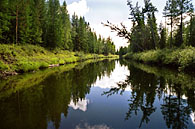Pearls of nature
Tungus Reserve
 Tungus National Natural Reserve is one of new nature-conservative, research and ecological-and-educational establishments.
Tungus National Natural Reserve is one of new nature-conservative, research and ecological-and-educational establishments.
The reserve is situated in Tungussko-Chunsky Region, Evenki AO, Krasnoyarsky Krai. It was established in 1996. The reserve's total area is 296 562 hectares, it includes the right bank of the Kimchu River and Lake Cheko (the northern border); its eastern border goes through the rivers Dyulyushma, Mamonnaya, Chamba; the southern border - through the right bank of the Podkamennaya Tunguska River; and the western border - first, through the right bank of the River Verkhnyaya La-Kura up to Piyunga Lake, then, trough the basins of the Yudukon and Mutorai Rivers and then - through the watershed of the Khushma River up to the River Kimchu.
The territory of the reserve represents typical north region of east-Siberian taiga with characteristic landscapes and biocenosises, almost absolutely untouched by anthropogenic factor.
This territory is unique. It stands out among all other reserves of the world because in 1908 in the territory between the rivers Khushma and Kimchu at the altitude of 5-10 km there was annihilation of a space object that is now known as 'The Tungus Meteorite". The nature of The Tungus Phenomenon remains undiscovered. The reserve represents exclusive interest as a unique area on the globe that provides an opportunity of direct studying of ecological consequences of space catastrophes.
Local climate is characterized by big amplitudes of changes in daily and seasonal temperature of air and soil. In summer temperature of air rises up to +30°C and higher, in winter it is -55, - 58°C. Snow cover is not deep and frost easily penetrates into the ground. The number of days when the temperature falls below 0°C equals 225.
The highest point of the reserve is the spurs of a hill chain named the Lakursky Ridge - 533 m above sea level. The second highest point - Farrington Mountain - is near the places of The Tungus Catastrophe. The chain of hills between the rivers Kimchu and Khushma is cut through by the Churgim Stream; that forms an effective cascade of 10 m high.
Larch and pine-and-larch woods prevail in the territory of the reserve. Vegetation of this area is rather various; all series of dynamically interrelated vegetative associations of Angarsky Biogeographical Region are represented. A big number of specially protected plants is found here.
The reserve's fauna is rich. It is represented by species typical of Central Siberian Middle Taiga zone. About 40 species of mammals are registered by zoologists in the territory of the reserve.
The species that have special trade value are: a sable, squirrel, elk, reindeer. The following species with low population should be also mentioned to complete the whole picture, they are: a lynx, brown bear, fox, glutton, musk deer, wolf.
A wood grouse, black grouse and hazel grouse are typical birds of the territory of the reserve. An erne, peregrine, fish-hawk and some other species registered in The Red Books of Russia and the USSR are as well met here. Besides, the routes of seasonal migration of birds also go through the reserve.
About 40 species of fish live in water areas of the reserve. Rare and trade species have special importance: a sterlet, Siberian sturgeon, white salmon, Yenisei river white-fish and others. On the whole the fauna is not sufficiently investigated, the further study may result in significant discoveries.
Marshlands occupy 15-20% of divide areas.
|